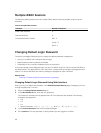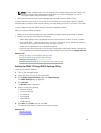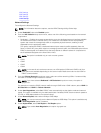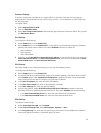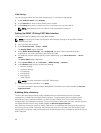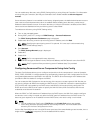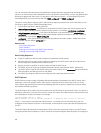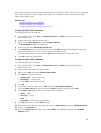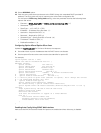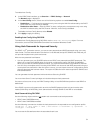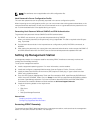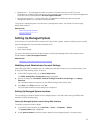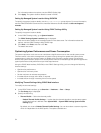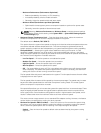
You can configure individual servers using different configuration files mapped using individual host
names. In an environment that has different servers with specific requirements, you can use different XML
filenames to distinguish each server. For example, if there are two servers – a PowerEdge R720 and a
PowerEdge R520, you must use two XML files, R720-config.xml and R520-config.xml.
The server-config-agent uses the rules in the following sequence to determine which XML file(s) on the
File Share to apply for each iDRAC/PowerEdge server:
1. The filename specified in DHCP option 60.
2. <ServiceTag>-config.xml - If a filename is not specified in DHCP option 60, use the system service
tag to uniquely identify the XML config file for the system. For example, <servicetag>-config.xml
3. <Model number>-config.xml - If the option 60 filename is not specified and the <ServiceTag>-
config.xml file is not found, then use the system Model number as the basis for the XML config file
name to use. For example, R520-config.xml.
4. config.xml – If the option 60 filename, service tag-based, and model number—based files are not
available, use the default config.xml file.
Related Links
Auto Config Sequence
DHCP Options
Enabling Auto Config Using iDRAC Web Interface
Enabling Auto Config Using RACADM
Auto Config Sequence
1. Create or modify the XML file that configures the attributes of Dell servers.
2. Place the XML file in a share location that is accessible by the DHCP server and all the Dell servers
that are assigned IP address from the DHCP server.
3. Specify the XML file location in vendor-option 43 field of DHCP server.
4. The iDRAC as part of acquiring IP address advertises vendor class identifier iDRAC. (Option 60)
5. The DHCP server matches the vendor class to the vendor option in the dhcpd.conf file and sends the
XML file location and XML file name to the iDRAC.
6. The iDRAC processes the XML file and configures all the attributes listed in the file
DHCP Options
DHCPv4 allows a large number of globally defined parameters to be passed to the DHCP clients. Each
parameter is known as a DHCP option. Each option is identified with an option tag, which is a 1 byte
value. Option tags 0 and 255 are reserved for padding and end of options, respectively. All other values
are available for defining options.
The DHCP Option 43 is used to send information from the DHCP server to the DHCP client. The option is
defined as a text string. This text string is set to contain the values of the XML filename, share location and
the credentials to access the location. For example,
option myname code 43 = text;
option myname "-l 10.35.175.88://xmlfiles –f dhcpProv.xml -u root -p calvin";
where, -l is the location of the Remote File Share and –f is the file name in the string along with the
credentials to the Remote File Share. In this example, root and calvin are the username and password to
the RFS.
The DHCP Option 60 identifies and associates a DHCP client with a particular vendor. Any DHCP server
configured to take action based on a client’s vendor ID should have Option 60 and Option 43 configured.
48



